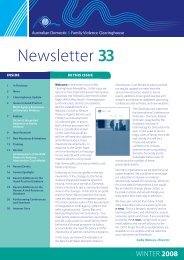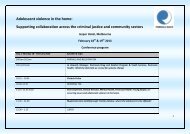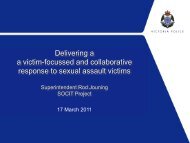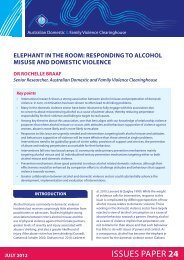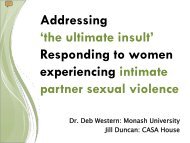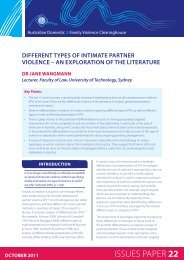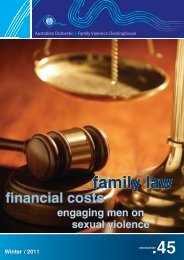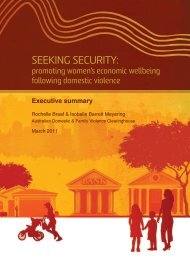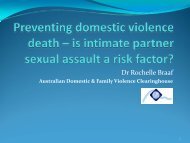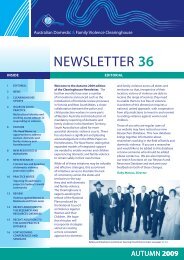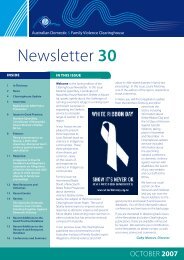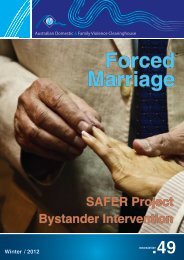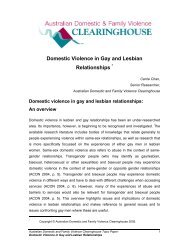Violence through our eyes - Women With Disabilities Australia
Violence through our eyes - Women With Disabilities Australia
Violence through our eyes - Women With Disabilities Australia
You also want an ePaper? Increase the reach of your titles
YUMPU automatically turns print PDFs into web optimized ePapers that Google loves.
interpreters or the publication of material in languages other than English) are often<br />
neglected.<br />
Service providers attending <strong>our</strong> forums sited access to interpreters as a key issue. Many<br />
indicated their funding arrangements did not include a budget for interpreters, despite the<br />
apparent need. As a consequence, family members are often used as interpreters. This<br />
not only breaches the confidentiality of the women, but also limits potential disclosure.<br />
The provision of culturally inappropriate services often results in women from NESB with<br />
disability having lower service usage rates in comparison to their Anglo-<strong>Australia</strong>n<br />
counterparts. This perpetuates the ‘they take care of their own’ myth and further limiting<br />
efforts by service providers to target women from NESB communities. As a consequence,<br />
women and carers use services only at crisis point.<br />
Accessing Information and Support<br />
Access to information is often the first step towards people making meaningful choices and<br />
participating in their communities. Access to information means in effect, access to<br />
opportunities and is elemental to making informed choices. For many women from NESB<br />
with disability there is limited access to culturally appropriate information. This means they<br />
have little awareness of support services available.<br />
It was apparent in the forums held by MDAA that women from NESB with disability have<br />
great difficulty navigating the complex ‘service-support system’. The women indicated they<br />
were referred to several services that assessed them. In many cases the women were<br />
referred back to the original referrer and were informed that their service only deals with<br />
one issue (domestic violence, disability or NESB). The reasons for referrals and<br />
assessment were in many cases poorly explained to the women, leaving them confused<br />
and disempowered. Additionally, they indicated that service providers did not inform them<br />
of their rights, their options and the internal and external complaints processes.<br />
Lack of co-ordination between services was also cited as an issue of concern. Service<br />
providers often lacked the skills to effectively reach and target the NESB population. This<br />
was compounded if the woman with disability had low levels of English language<br />
proficiency, and/or had difficulty communicating with services. This was of particular<br />
concern where the service was unwilling or lacked the skills to effectively use a<br />
professional interpreter.<br />
Socio-economic Disadvantage<br />
In general, people from NESB rank lower on socio-economic scales than their Anglo-<br />
<strong>Australia</strong>n counterparts. <strong>Women</strong> with disability are most likely to be in the lowest income<br />
earning bracket. Further, they are more likely to be institutionalised and less likely to be<br />
employed or own their own accommodation than men with disability or women without<br />
disability. This is often explained by proficiency in English, the levels and recognition of<br />
educational qualifications and the levels and recognition of work skills and experience.<br />
In <strong>Australia</strong> all migrants without disability (except for those migrating on humanitarian<br />
grounds) have to wait two years before they can access income and social support.<br />
However, migrants with disability, including their carers, have to wait ten years before<br />
being deemed eligible for the Disability Support Pension (DSP) or carer. This is specified<br />
in the Social Security Act 1991 (s94). In addition, receipt of the DSP forms part of the<br />
eligibility criteria for essential disability services and equipment such as Post-School<br />
Options Programs, Home and Community Care (HACC) and the Program of Appliances<br />
<strong>Violence</strong> <strong>through</strong> <strong>our</strong> <strong>eyes</strong> 14



